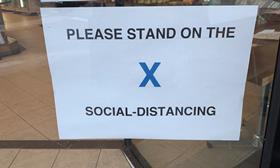
Circles and crosses. Since the beginning of the Covid-19 pandemic we’ve seen more and more of these symbols. Quite literally, ‘X’ has been used to mark the spot; stand here, go there, don’t go there.
Circles have been used in similar fashion. At a local park here in Melbourne they were drawn on lawns, designating where and who you can sit with.
Circles are very pertinent in our industry too. Think about the circular economy everyone is talking about with respect to packaging. It now relates to creating value out of waste streams and increased recycling targets, alongside reducing waste and increasing renewable resources.
In this regard, our industry has a collective target in its sights; the 2025 Sustainable Development Goals outlined by the United Nations (UN).
This push is being backed by major retailers and their agendas, which are now being promoted on all channels to consumers.
THE JOURNEY
Whether you’re calling them sustainability ‘targets’ or ‘goals’, they require your company to develop a strategy and make a commitment. Again, X marks the spot, and the UN has decreed 2025 is that spot.
The targets set by the UN are concise but the road to reaching them is not. How can we ensure when we aim and fire, we’ll hit that X in the middle of our circles? We can start by understanding what those circles are.
The outer circle: Consumers. Ideas, like sustainability, begin in the outer circle. It’s where the decisions of purchase are made. Sustainability may have first been prevalent in the shoeless communes of 1970s hippies, but now it’s in almost every consumer circle. Whether that be middle class consumers discussing the source of their local café’s coffee beans, or well-to-do consumers buying a battery-powered Tesla, instead of a petrol-gargling Ferrari.
The middle circle: Industry. Consumers are choosing to buy under a certain ideology. This thought process will permeate into the industry through consumption trends, icon endorsements and the illustrious hashtag movement. The middle circle comprises outlets, distributors, packaging, marketing, and the rest. However, when the industry comes together on something like sustainability, it generates momentum. A lot of it.
The inner circle: Executives. Change flows upward. This circle is where policy is made and redirection can happen. The desks of the inner circle are where the dossiers of the 2025 targets sit. It’s where company strategies culminate into policies. It’s where the consumer trend, which became the industry idea, becomes the company commitment.
So, if sustainability has permeated through all circles of the target, does that mean it’s hit the X? Not yet.
THE SOLUTION
There is no packaging holy grail; one packaging format won’t fix all of the world’s problems. The solution is no longer a model of ‘either/or’ but a model of ‘as well as’.
Much like the circular economy model that underpins many sustainability commitments, you need to learn how to maximise what you already have before chasing something new. Examining your assets allows you to optimise them, reuse and recycle what you can, and reduce figurative and literal waste.
Like two circles of a Venn diagram, you begin that transition when you can find the overlap between old and new. Even if these ideals sometimes seem at odds, the path from ‘this to that’ always has a point where the two must co-exist. Embracing this co-existence is the final ingredient to your circular cocktail of success.
As it stands, we’ve checked off every circle. The consumers, industry and executives are on board. Now we’ve got to optimise what we have. I’m confident we won’t miss the target.



